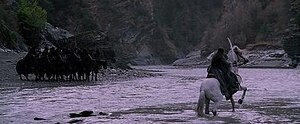"Kind words can be short and easy to speak, but their echoes are truly endless." -- Mark Twain
As I read these words, I am reminded of what William Penn, Quaker and namesake of Pennsylvania, said: "Let us then try what love can do to mend a broken world."
When I talk about kindness and compassion, the state of the world often is the first thing that comes to mind. As I write this, folks are struggling to come to terms with and respond appropriately (or not) to events of spectacular violence. We're all feeling shaken. There's a great deal of public discourse about compassion vs retaliation vs pre-emptive action vs addressing root causes, so there is no need to elaborate here.
Kindness can exist "out there in the world" and it can exist inside ourselves, a quality to be cultivated. It is also an important consideration in the creation and development of fictional characters. First and foremost, just about everyone except sociopaths has some degree of kindness and it manifests to one degree or another in various ways under various circumstances. Sometimes it seems that authors are so fixated on dynamic action or escalating tension or nifty gee-whiz ideas that they forget the role of kindness in every human interaction. (In science fiction and fantasy, this includes non-humans as well!) It may be a small role, or so tiny as to be undetectable, or it may be the dominant emotional axis, but it is always there.
Last night, I was watching a movie and noted that a series of breakneck action scenes was followed by a short catch-your-breath pause. Characters are binding up their wounds, repairing their weapons, that sort of thing. And there was a moment of kindness. Not the expected sort of comforting the injured or checking to see how everyone fared. This moment had more to do with taking that kindness a step further so that the care-taking character could see the good they had done.
Nationally, we talk about the Gross National Product, the total worth of all the products and services produced in one year in a given country. Well, the ones that are typically measured in dollars or shekels or pounds. Some years ago, the King of Bhutan talked about the Gross National Happiness, as if that, too, were something that can be quantified. How about a Gross National Kindness? Or, more specific to story-tellers, the Greater Narrative Kindness?
Kindness isn't about feel-good, let's-all-be-best-friends naive solutions to dramatic problems, or conflicts arising from powerful forces like scarce resources, injustice, blind ambition, or utter evil? It's about small deeds that weave together the lives of the characters, creating and sustaining loyalty and friendship, even devotion. It also isn't an either/or on/off thing.
One way to add depth and complexity, not to mention sympathy, to your characters is to take note of where they are on this spectrum of kindness at any given time and with these particular other characters. The most straightforward presentation is externally observable kind words or deeds. But it might also be that your character is feeling distinctly unkind -- how does that influence his behavior? her speech -- words, tone, contrast with body language? Or your character might be
feeling kindness but unable to express it. This opens a host of possibilities for letting the reader know, for revealing and deepening that character.
Or -- and here the potential gets really juicy -- a character who
feels no kindness but nevertheless
acts in a kind way. Why the discrepancy? Is this an unfeeling person? Or a person who might be kind under other circumstances but not these? Why then behave contrary to genuine feeling? What does she have to gain? And
how does the very act of kindness change her?
I'd love to hear your thoughts on the role of kindness in character and story.

















